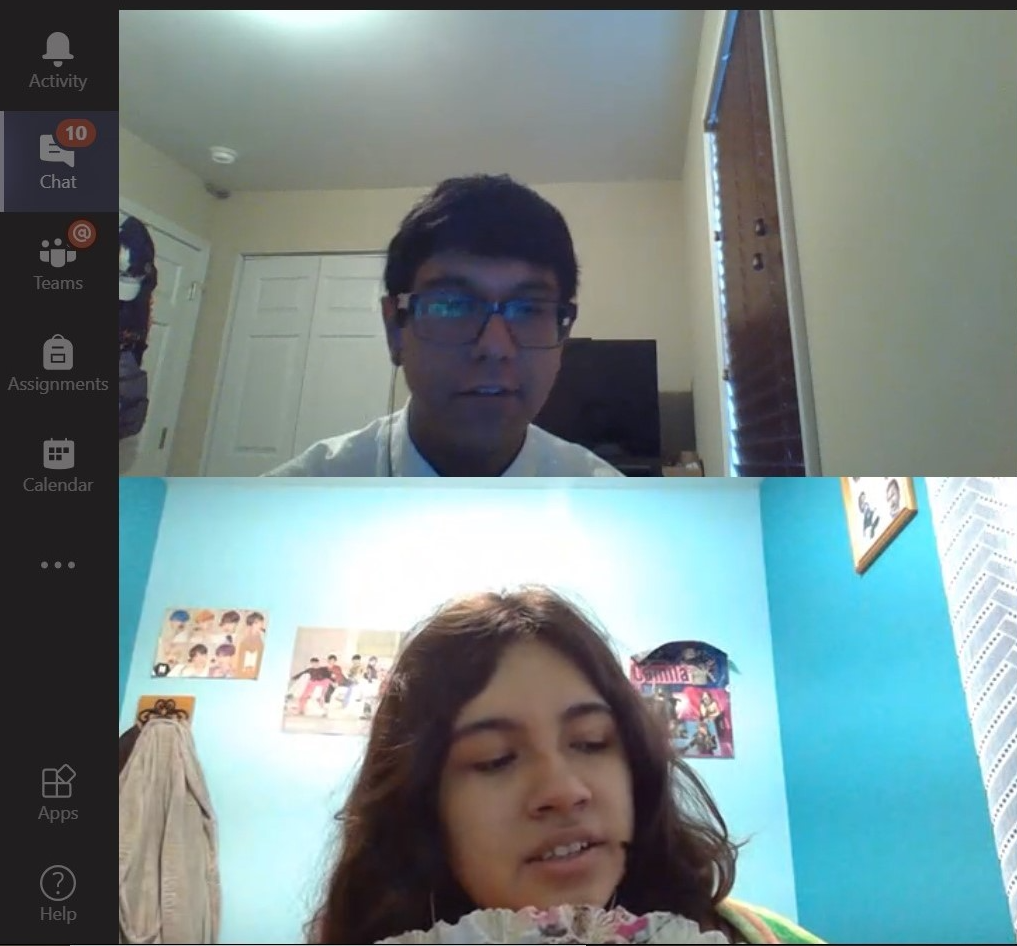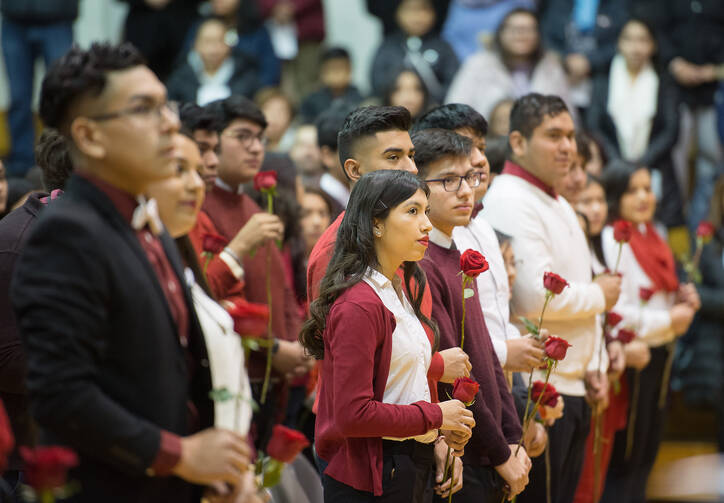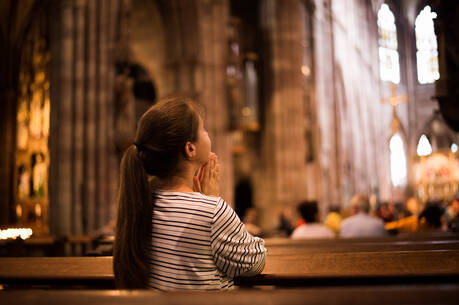I had never seen a cougar up close until I became a teacher at Cristo Rey Jesuit High School in southwest Chicago. Twenty years ago, I stood in a chaotic hallway just after dismissal one afternoon, faced with a freshman who had failed to follow directions for an assignment. The class was multidisciplinary, and Ramon’s role in his group was to research a mascot for them and create a miniature out of clay. Each cooperative learning group had received an identical gray slab of clay about two inches by five inches, sealed in translucent plastic.
“I made a cougar, but not with clay,” Ramon informed me when he arrived empty-handed in the hallway outside the computer lab.
“How come?” I asked. “Remember we talked about it in class? So everyone can make something different out of the same material.”
We struggled to hear each other over the sound of lockers slamming shut and students calling to each other in Spanish and English. I said his team probably would lose points unless he could make a mascot that night, using clay. Ramon looked down at his dress tie and said he would try.
But something made me ask to see the clay-free cougar, which Ramon retrieved from his locker.
Haunting amber eyes peered at me from the head of Ramon’s sculpture. A papier-mâché body the size of a cat shone burnt orange with a paler underbelly, and even mixed-in camouflage. “Wow,” I said, or some other absurd understatement, as I reached to touch one of the cougar’s fine, gray-yarn whiskers.
“Does it count?” Ramon finally asked, his face more hopeful. I nodded. “We’ll get a bigger display case,” I said.
My initial insistence on clay and uniformity was academically fair, but I had shown a distinct lack of imagination, a tool that my Jesuit employers deemed essential for discerning Jesus’ presence in the world. Seeing Ramon’s alternate creation gave me insight into his artistic learning process, and I could picture the years he had worked in grade school developing his skills.
My initial insistence on uniformity was academically fair, but I had shown a distinct lack of imagination, a tool that my Jesuit employers deemed essential for discerning Jesus’ presence in the world.
The cougar also connected me in a small way to our school’s most important religious festival, the feast of Our Lady of Guadalupe. Every Dec. 12 our senior students re-enact the visitations of Juan Diego, an Indigenous peasant, with the Virgin Mary in December 1531 near today’s Mexico City. The caramel-skinned apparition asked Juan Diego to visit the local Spanish archbishop and request that he build a church in her honor.
Predictably, the stern archbishop and his assistants ridiculed Juan Diego, but they soon had to recant when he arrived with proof: an image of the Virgin on his tunic as well as fresh roses picked from the frozen winter tundra. Our students loved to re-enact the scene where the mortified archbishop threw himself at Juan Diego’s feet and promised to construct the basilica.
Ramon’s papier-mâché cougar could be considered my pedagogical bouquet of winter roses. During the following 19 years, I have continued to encounter this rare pairing of creativity and grace in students and colleagues. This year our school will mark its 25th anniversary, which we will celebrate, of course, but while operating under the scourge of Covid-19 and widespread racial unrest. Physically, emotionally and financially, our students and their communities are affected disproportionately. The pandemic is putting a particular strain on our school’s work-study model, which depends on the students’ corporate internships.
This year our school will mark its 25th anniversary, which we will celebrate, of course, but while operating under the scourge of Covid-19 and widespread racial unrest.
Once again, I have seen Cristo Rey students apply their creativity and skills to the urgent social justice issues swirling around their neighborhoods. Last spring, Lizbeth, a student in my sophomore English class, turned a project on writing advocacy letters into a video about a racial unity rally in which she participated.
Nearly 1,000 Latino and African-American teens marched peacefully in the video, made in June, brandishing the Mexican flag alongside a homemade sign saying, “George Floyd’s Life Matters.” Most of the young people wore facemasks in the demonstration, which they called the Youth-Led Black and Brown Unity March.
“We’ve been going through a hard time, and it’s really important that we stick together and inform ourselves,” Lizbeth narrated over the images. Switching to Spanish at times, she also wove in reflective interviews with teens throughout the video. Near the end, she included footage of herself taking the podium to speak from her unique perspective: born and raised in a predominantly Latino neighborhood but currently living with her family in an African-American community, where she has witnessed disrespectful treatment of neighbors by law authorities.
“Tu Lucha es Mi Lucha” (“Your Struggle is My Struggle”) Lizbeth titled her artful and ultimately hopeful video.
Our students and their families have continually shown unusual resourcefulness and adaptability to sudden crises and disappointments.
Our students and their families have continually shown unusual resourcefulness and adaptability to sudden crises and disappointments. They have practice, as many have made lives for themselves in Chicago as immigrants on modest incomes. Last spring, for instance, several students in my talented improv club found out that their study-abroad scholarships to Italy, France and Japan were canceled, depriving them of rare opportunities for travel and education overseas. Valentina, a rising senior, told us that the news made her cry in her room for a week. For months, she had been learning Italian and looking forward to trading Mexican recipes for Italian dishes with her host family. She planned out visits to the Colosseum and Catacombs.
Instead, Valentina worked all summer in the frigid office of a poultry factory. The tasks were different than at the large law firm where she interned for Cristo Rey, but she used similar communication and coordination skills. Valentina remains hopeful about visiting Rome next summer.
Back in June, at our final online meeting of the year, my improv students were despondent about their thwarted plans, and they feared for their families’ futures. Tuning in from my laptop two neighborhoods away, I felt angry and frustrated on their behalf. The session appeared to be doing more harm than good without our usual skits and moments of levity. Then I remembered “Consolation,” a tongue-in-cheek poem by Billy Collins, where the speaker feigns delight that he will not have to spend the summer in Italy as planned.
This fall, every time I see my students’ faces—whether masked and in-person or unmasked and online—I’ll be reminded of the mantra from the video: Tu lucha es mi lucha. Your struggle is mine.
Impulsively, I asked the students in their glowing screen boxes if they would like to hear a “funny” poem about someone else’s canceled trip. While many teens would have hesitated or claimed an urgent task elsewhere, this group was game.
I admit to feeling a moment of panic as we listened to the YouTube clip, fearing it might be too raw a topic yet for humor. But soon, I heard laughter rumble from my computer’s speakers, after lines like “instead of slouching in a cafe, ignorant of the word for ice/ I will head down to the coffee shop/ and the waitress known as Dot.”
Recently, I asked Valentina how she was able to embrace the poem’s comedy so quickly, and she said it offered solidarity. “I kept saying in my mind, ‘Bro, me, too,’ and, ‘That’s such a mood.’”

Jesuit theology deeply explores the concept of consolation. Just feeling good is spiritually different from the sensation of feeling one’s “heart drawn to God,” even if the circumstances are outwardly negative, bleak. For me, the distinction is not always obvious at first, but in my two decades at Cristo Rey, I’ve learned to recognize some of the hallmarks.
Twenty years ago, when I left newspaper journalism and college teaching to begin at the high school, some people asked why I would want to spend so much time in the company of teenagers. I said I thought they were more honest than many adults and that I would get to be there when they read Shakespeare for the first time.
I had no sense of how much the students’ generous, creative natures would help me with some of the most significant transitions of my own life, including the births of my children, the death of my father and even the adoption of a fiery rescue dog.
Now, with Covid-19, we are navigating a new and troubling period together. This fall, every time I see my students’ faces—whether masked and in-person or unmasked and online—I’ll be reminded of the mantra from the video: Tu lucha es mi lucha. Your struggle is mine.









